1. Introduction – Difference between dhoti and lungi
In this article, let us understand why dhotī is more sāttvik and appropriate as per Hindu Dharma as compared to lungī, even though lungī has been traditional attire. Let us also go through some obvious difference between Dhoti and Lungi.
The attire conducive to spiritual practice in the corresponding environment is represented by ‘sovalē’ in North Bharat and ‘lungī’ in South Bharat.
2. Reason behind adoption of lungī in South Bharat 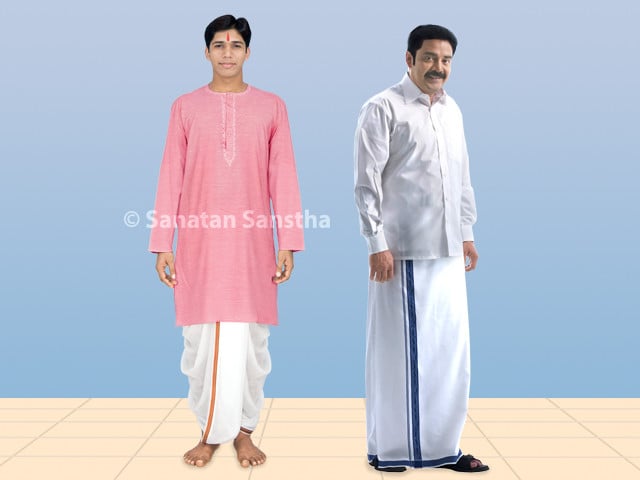
2A. Lungī : Culture of South Bharat is more activity-oriented. To stimulate this activity-oriented nature of the society, activity-oriented culture that inculcates Raja component came into existence. Since the environment in this region is hot, the sphere of activity is conducive to movements that are part of the rituals. Therefore, attire such as lungī, which has the utmost ability to attract and swiftly emit waves of Raja component, was adopted.
2B. Sovalē : Sovalē is Sattva-predominant. It was accepted at the level of sanskārs (subconscious impressions) as the main attire of the karma (An act)-predominant culture. A sovalē is made of natural silk. Hence, it has the ability to attract Sattva-predominant waves, congregate them at the respective level and then emit them according to the need. Therefore, Brāhman (One who belongs to the first of the four varṇas [Classes], studies scriptures and imparts knowledge to the society) class that strictly followed Āchārdharma (Code of righteous conduct) established this attire, thereby, efforts to preserve the sāttvik karma-predominant culture with its Vēdic mantras were made. Maharashtra (A State in Bharat), which nurtures the Brahman class, has a balanced climate that is complementary to the functioning of the sushumnā-nādī (Central channel of the spiritual energy flow system). Therefore, sovalē, which is complementary to Sattva oriented karma-predominant culture and one that helps in preservation of Sattva enhancing culture, came into existence in that environment.
The basic Sattva component enhancing ability in creating sanskārs in the karma-predominant Brahman class in Maharashtra originated through the study of Vedas and associated mantras. While, its Raja-predominant acts related to rituals became complementary for the South Bharatiya Brahman class to perform spiritual practice with the help of this conducive environment. Hence, according to the division of tasks between these classes, sanskār-oriented and action-oriented culture arose through attires of sovalē and lungī. Thus, the attires complementary to the spiritual practice as per the prevailing environment were created.
3. Why is it that most Deities
in the temples in South Bharat
are dressed in a dhoti and not in a lungi ?
Lungī is a traditionally accepted attire in South Bharat. Lungī as an attire is considered unacceptable by Hindu Dharma. In South Bharat, it is a traditionally accepted rule. A rule is man-made, while the sāttvik processes that are created through the Āchārs approved by Hindu Dharma are God-made.
4. Difference between a dhoti and lungi
4A. Dhotī has the ability to imbibe and emit Sattva component, while lungī has insignificant ability to hold sāttvik waves. Hence, Hindu Dharma has not given acceptance to wearing of a lungī.
4B. The design of a lungī is such that it has greater ability to emit waves of Raja component. Therefore, there is a greater possibility of negative energies getting attracted to the swift activities in progress, based on Raja component. Hence, Hindu culture considers lungī unacceptable. Conversely, the manner of wearing a dhotī is sāttvik, and hence, it is an attire that is created through the Divine culture. It is because of the sāttvikta of the attire, that it remained restricted only to Deities in temples of South Bharat.
4C. The harmful effects of wearing lungī : In adopting lungī as an attire, man has interfered with sāttvik attires that have been approved by Hindu Dharma since the Vedic times. He has, thereby, reduced his ability to imbibe Chaitanya-predominant waves that emanate from God, and caused harm to himself at the spiritual level. Hence, despite the temples in South Bharat being sāttvik, man has failed to obtain benefits from their sāttvikta due to the use of attire such as lungī that functions at an inferior level. This is a good example of how local tradition becomes responsible for the spiritual decline of human beings.
5. Difference in religious rituals
performed while wearing a lungī, dhotī and sovalē
| While wearing a lungī | While wearing a dhotī | While wearing a sovalē | |
|---|---|---|---|
| Principal component | Indicative of Raja component | Indicative of Sattva-Raja components | Indicative of Sattva component |
| Level | Activity-oriented | Karma-activity-oriented | Culture-oriented |
| Ability | Emission of Raja-predominant waves to the utmost extent | Imbibing and emission of waves of Sattva-Raja component to a relatively lesser extent | Imbibing and emission of waves of Sattva component to the utmost extent |
| Function | Imbibing and emission of waves of Raja component proportionate to the energy of bhāv (Spiritual emotion) | Imbibing and emission of waves of Raja-Sattva component proportionate to the energy of bhāv | Imbibing waves of Sattva component, congregating them in the pleats of the sovalē and emitting them as per the need |
| Channel activated | Right (Useful for a mārak [Destroyer] mission) | Left (Useful for a tārak [Saviour] mission) | Sushumnā (The central channel of the spiritual energy flow system, which extends from the base of the spine to the top of the head) (Tārak-mārak as per the need) |
| Effect on the mind | Becomes enthusiastic | Becomes cheerful | Becomes stable |
| Effect on the body | Movements takes place, that are conducive to the karma | Activity takes place according to the Sattva-predominant thoughts | Emission of virtuous thoughts from the body through the medium of good sanskārs |
| Spiritual experience | Imparting Shaktī (Divine Energy) | Imparting Shaktī and Chaitanya | Imparting Chaitanya |
Reference: Sanatan Sanstha’s Holy Text ‘Spiritually beneficial clothes for men’

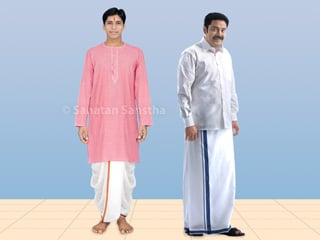
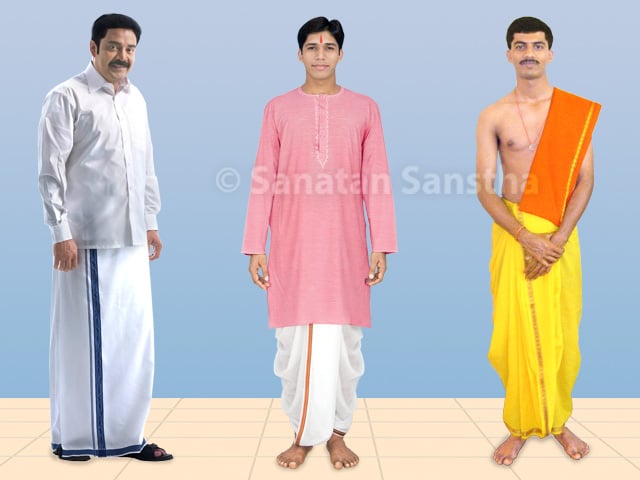
 Sewing Clothes and Effect of Stitching
Sewing Clothes and Effect of Stitching Practical suggestions on Wearing Clothes
Practical suggestions on Wearing Clothes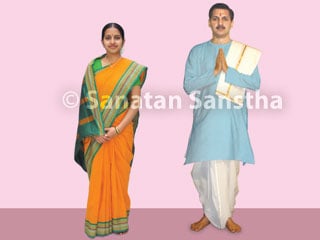 Why do we wear clothes ? and Importance of wearing Sattvik Clothes
Why do we wear clothes ? and Importance of wearing Sattvik Clothes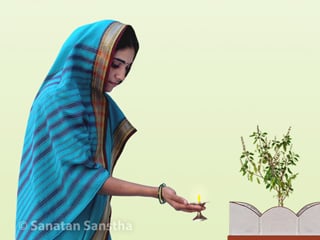 Significance of taking saree pallu (free end of the saree) over head
Significance of taking saree pallu (free end of the saree) over head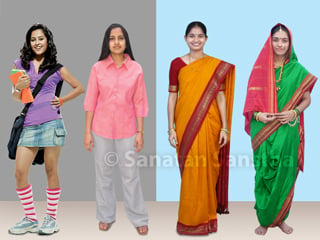 Subtle effect and Importance of dress worn by a woman
Subtle effect and Importance of dress worn by a woman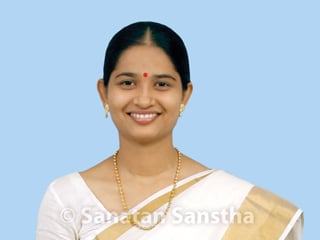 Subtle effects of different neckline patterns of a garment worn by women
Subtle effects of different neckline patterns of a garment worn by women